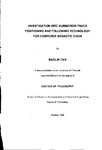INVESTIGATION INTO SUBMICRON TRACK POSITIONING AND FOLLOWING TECHNOLOGY FOR COMPUTER MAGNETIC DISKS
| dc.contributor.author | TAN, BAOLIN | |
| dc.contributor.other | School of Engineering, Computing and Mathematics | en_US |
| dc.date.accessioned | 2013-10-18T11:11:00Z | |
| dc.date.available | 2013-10-18T11:11:00Z | |
| dc.date.issued | 1998 | |
| dc.identifier | NOT AVAILABLE | en_US |
| dc.identifier.uri | http://hdl.handle.net/10026.1/2226 | |
| dc.description.abstract |
In the recent past some magnetic heads with submicron trackwidth have been developed in order to increase track density of computer magnetic disks, however a servo control system for a submicron trackwidth head has not been investigated. The main objectives of this work are to investigate and develop a new servo pattern recording model, a new position sensor, actuator, servo controller used for submicron track positioning and following on a computer hard disk with ultrahigh track density, to increase its capacity. In this position sensor study, new modes of reading and writing servo information for longitudinal and perpendicular magnetic recording have been developed. The read/write processes in the model have been studied including the recording trackwidth, the bit length, the length and shape of the transition, the relationship between the length of the MR head and the recording wavelength, and the SIN of readout. lt has also been investigated that the servo patterns are magnetized along the radial direction by a transverse writing head that is aligned at right angles with the normal data head and the servo signals are reproduced by a transverse MR head with its stripe and pole gap tangential to the circumferential direction. lt has been studied how the servo signal amplitude and linearity are affected by the length of the MR sensor and the distance between the shields of the head. Such things as the spacing and length of the servo-pattern elements have been optimised so as to achieve minimum jitter and maximum utilisation of the surface of the disk. The factors (i.e. the skew angle of the head) affecting the SIN of the position sensor have been analysed and demonstrated. As a further development, a buried servo method has been studied which uses a servo layer underneath the data layer, so that a continuous servo signal is obtained. A new piezo-electric bimorph actuator has been demonstrated. This can be used as a fine actuator in hard disk recording. The linearity and delay of its response are improved by designing a circuit and selecting a dimension of the bimorph element. A dual-stage actuator has been developed. A novel integrated fine actuator using a piezo-electric bimorph has also been designed. A new type of construction for a magnetic head and actuator has been studied. A servo controller for a dual-stage actuator has been developed. The wholly digital controller for positioning and following has been designed and its performances have been simulated by the MAL TAB computer program. A submicron servo track writer and a laser system measuring dynamic micro-movement of a magnetic head have been specially developed for this project. Finally, track positioning and following on 0.7 µm tracks with a 7% trackwidth rms runout has been demonstrated using the new servo method when the disk-was rotating at low speed. This is one of the best results in this field in the world. | en_US |
| dc.language.iso | en | en_US |
| dc.publisher | University of Plymouth | en_US |
| dc.title | INVESTIGATION INTO SUBMICRON TRACK POSITIONING AND FOLLOWING TECHNOLOGY FOR COMPUTER MAGNETIC DISKS | en_US |
| dc.type | Thesis | |
| dc.identifier.doi | http://dx.doi.org/10.24382/4687 | |
| dc.identifier.doi | http://dx.doi.org/10.24382/4687 |
Files in this item
This item appears in the following Collection(s)
-
01 Research Theses Main Collection
Research Theses Main


